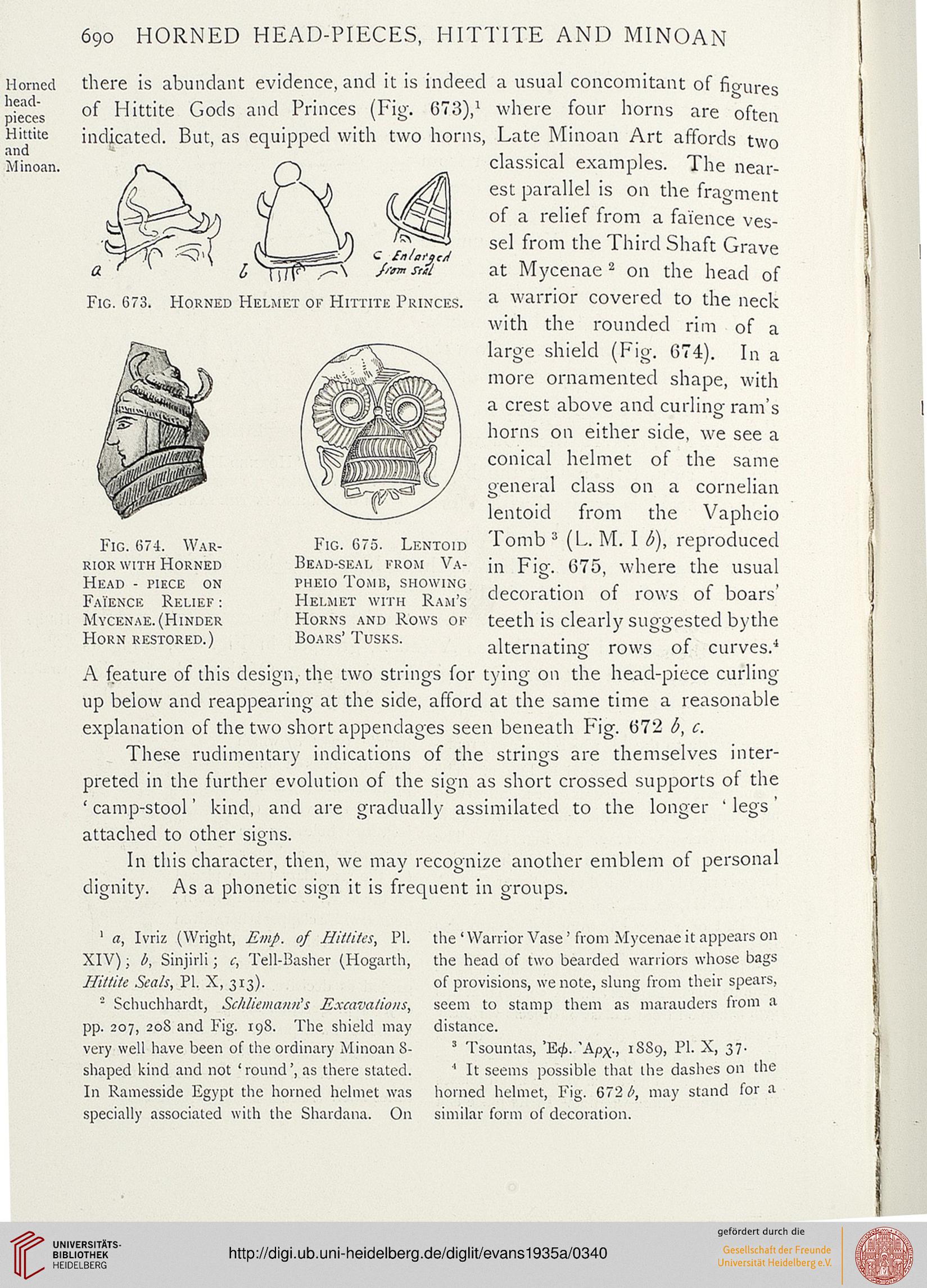J/Vm Stat
Horned Helmet of Hittite Princes.
690 HORNED HEAD-PIECES, HITI'ITE AND MINOAN
there is abundant evidence, and it is indeed a usual concomitant of figures
of Hittite Gods and Princes (Fig. 673)/ where four horns are often
indicated. But, as equipped with two horns, Late Minoan Art affords two
classical examples. The near
A
m
est parallel is on the frao-ment
of a relief from a faience ves-
sel from the Third Shaft Grave
at Mycenae 2 on the head of
a warrior covered to the neck
with the rounded rim of a
large shield (Fig. 674). In a
more ornamented shape, with
a crest above and curling ram's
horns on either side, we see a
conical helmet of the same
general class on a cornelian
lentoid from the Vapheio
Fig. 675. Lentoid Tomb 3 (L. M. I A), reproduced
Bead-seal from Va- in Fig. 675, where the usual
decoration of rows of boars'
teeth is clearly suggested bythe
alternating rows of curves.4
A feature of this design, the two strings for tying on the head-piece curling
up below and reappearing at the side, afford at the same time a reasonable
explanation of the two short appendages seen beneath Fig. 672 6, c.
These rudimentary indications of the strings are themselves inter-
preted in the further evolution of the sign as short crossed supports of the
' camp-stool' kind, and are gradually assimilated to the longer ' legs'
attached to other signs.
In this character, then, we may recognize another emblem of personal
dignity. Asa phonetic sign it is frequent in groups.
Fig. 674. War-
rior with Horned
Head - piece on
Faience Relief :
Mycenae. (Hinder
Horn restored.)
pheio Tomb, showing
Helmet with Ram's
Horns and Rows of
Boars' Tusks.
1 a, Ivriz (Wright, Emp. of Iiiitites, PI.
XIV); *, Sinjirli; c, Tell-Basher (Hogarth,
Hittite Seals, PL X, 313).
2 Schuchhardt, Schliemaim's Excavations,
pp. 207, 208 and Fig. 19S. The shield may
very well have been of the ordinary Minoan 8-
shaped kind and not (round', as there stated.
In Ramesside Egypt the horned helmet was
specially associated with the Shardana. On
the ' Warrior Vase ' from Mycenae it appears on
the head of two bearded warriors whose bags
of provisions, we note, slung from their spears,
seem to stamp them as marauders from a
distance.
' Tsounlas, 'E<£. 'Apx-, 1SS9, PI. X, 37-
4 It seems possible that the dashes on the
horned helmet, Fig. 672*, may stand for a
similar form of decoration.
Horned Helmet of Hittite Princes.
690 HORNED HEAD-PIECES, HITI'ITE AND MINOAN
there is abundant evidence, and it is indeed a usual concomitant of figures
of Hittite Gods and Princes (Fig. 673)/ where four horns are often
indicated. But, as equipped with two horns, Late Minoan Art affords two
classical examples. The near
A
m
est parallel is on the frao-ment
of a relief from a faience ves-
sel from the Third Shaft Grave
at Mycenae 2 on the head of
a warrior covered to the neck
with the rounded rim of a
large shield (Fig. 674). In a
more ornamented shape, with
a crest above and curling ram's
horns on either side, we see a
conical helmet of the same
general class on a cornelian
lentoid from the Vapheio
Fig. 675. Lentoid Tomb 3 (L. M. I A), reproduced
Bead-seal from Va- in Fig. 675, where the usual
decoration of rows of boars'
teeth is clearly suggested bythe
alternating rows of curves.4
A feature of this design, the two strings for tying on the head-piece curling
up below and reappearing at the side, afford at the same time a reasonable
explanation of the two short appendages seen beneath Fig. 672 6, c.
These rudimentary indications of the strings are themselves inter-
preted in the further evolution of the sign as short crossed supports of the
' camp-stool' kind, and are gradually assimilated to the longer ' legs'
attached to other signs.
In this character, then, we may recognize another emblem of personal
dignity. Asa phonetic sign it is frequent in groups.
Fig. 674. War-
rior with Horned
Head - piece on
Faience Relief :
Mycenae. (Hinder
Horn restored.)
pheio Tomb, showing
Helmet with Ram's
Horns and Rows of
Boars' Tusks.
1 a, Ivriz (Wright, Emp. of Iiiitites, PI.
XIV); *, Sinjirli; c, Tell-Basher (Hogarth,
Hittite Seals, PL X, 313).
2 Schuchhardt, Schliemaim's Excavations,
pp. 207, 208 and Fig. 19S. The shield may
very well have been of the ordinary Minoan 8-
shaped kind and not (round', as there stated.
In Ramesside Egypt the horned helmet was
specially associated with the Shardana. On
the ' Warrior Vase ' from Mycenae it appears on
the head of two bearded warriors whose bags
of provisions, we note, slung from their spears,
seem to stamp them as marauders from a
distance.
' Tsounlas, 'E<£. 'Apx-, 1SS9, PI. X, 37-
4 It seems possible that the dashes on the
horned helmet, Fig. 672*, may stand for a
similar form of decoration.





